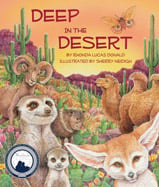Alignment to Standards for KY

| Grade | Number | Standard |
|---|---|---|
| 4 | SC-04-3.4.1a | compare the different structures and functions of plants and animals that contribute to the growth, survival and reproduction of the organisms; |
| 4 | SC-04-3.4.1b | make inferences about the relationship between structure and function in organisms. Each plant or animal has structures that serve different functions in growth, survival and reproduction. For example, humans have distinct body structures for walking |
| 4 | SC-04-4.6.1 | the basic relationships of plants and animals in an ecosystem (food chain). |
| 4 | SC-04-4.6.1a | Plants make their own food. All animals depend on plants. Some animals eat plants for food. Other animals eat animals that eat the plants. |
| 4 | SC-04-4.7.1a | patterns of evidence related to the survival and reproductive success of organisms in particular environments. |
| 4 | SC-04-4.7.1b | Distinct environments support the lives of different types of organisms. |
| 4 | SC-4-ET-S-1 | observe/construct, analyze patterns and explain basic relationships of plants and animals in an ecosystem (e.g., food webs) |
| 4 | SC-4-ET-U-1 | ecosystems are defined by the relationships that occur within them. These relationships can be determined through observation of the organisms and their environment. |
| 4 | SC-4-I-S-1 | cause and effect relationships existing between organisms and their environments |
| 4 | SC-4-I-U-1 | all living things depend on their environment and other organisms within it for their survival. Certain patterns of behavior or physical features may help an organism survive in some environments yet perish in others. |
| 4 | SC-4-I-U-2 | environmental relationships extend beyond food (e.g. shelter, seed transport). |
| 4 | SC-4-UD-U-2 | characteristics of living things can be used to sort them into various groups: the characteristics chosen to establish the grouping depend on the reason for the grouping. |
| 5 | SC-5-I-U-2 | populations interact with each other in an ecosystem form a specific community, but there may be multiple communities within the same ecosystem. |
| Primary | SC-EP-3.4.3 | Students will describe the basic structures and related functions of plants and animals that contribute to growth, reproduction and survival. |
| Primary | SC-EP-3.4.3a | Each plant or animal has observable structures that serve different functions in growth, survival and reproduction. For example, humans have distinct body structures for walking, holding, seeing and talking. These observable structures should be explored |
| Primary | SC-EP-4.6.1 | basic relationships of plants and animals in an ecosystem (food chains/interdependance). |
| Primary | SC-EP-4.6.2 | Plants make their own food. All animals depend on plants. Some animals eat plants for food. Other animals eat animals that eat the plants. Basic relationships and connections between organisms in food chains can be used to discover patterns within ecosystems |
| Primary | SC-EP-4.7.1 | cause and effect relationships existing between organisms and their environments. |
| Primary | SC-EP-4.7.1a | Organisms require an environment in which their needs can be met. When the environment changes some plants and animals survive and reproduce and others die or move to new locations. |
| Primary | SC-P-BC-U-2 | understand that living things are found almost everywhere on our planet, but organisms living in one place may be different from those found somewhere else. |
| Primary | SC-P-ET-S-3 | basic relationships of plants and animals in an ecosystem (simple food chains and webs) |
| Primary | SC-P-I-S-1 | characteristics of an ecosystem |
| Primary | SC-P-I-S-2 | how organisms depend on their environments |
| Primary | SC-P-I-U-1 | the world has many different environments. Distinct environments support the lives of different types of organisms. |
| Primary | SC-P-UD-S-2 | identify the characteristics that define a habitat |
| Primary | SC-P-UD-S-3 | Students will investigate adaptations that enable animals and plants to grow, reproduce and survive (e.g., movements, body coverings, method of reproduction) |
| Primary | SC-P-UD-S-4 | Students will analyze structures of plants and animals to make inferences about the types of environments for which they are suited |
| Primary | SC-P-UD-U-2 | plants and animals have features that help them live in different environments. |
| Primary | SC-P-UD-U-3 | some animals are alike in the way they look and in the things they do, and others are very different from one another. |
| Primary | SS-EP-4.1.1 | Students will use geographic tools (e.g., maps, globes, mental maps, charts, graphs) to locate and describe familiar places at home, school and the community. |
| Primary | SS-EP-4.1.2 | use geographic tools to identify major landforms (e.g., continents, mountain ranges), bodies of water (e.g., oceans, major rivers) and natural resources on Earthês surface and use relative location. |
| Primary | SS-EP-4.2.1 | places on Earthês surface by their physical characteristics (e.g., climate, landforms, bodies of water). |
| Primary | SS-P,4&5-G-U-1 | use of geographic tools (e.g., maps, globes, charts, graphs) and mental maps help interpret information, understand and analyze patterns, spatial data and geographic issues. |
| Primary | SS-P-G-S-1c | identify major landforms (e.g., continents, mountain ranges) and major bodies of water (e.g., oceans, rivers) |
| Primary | SS-P-G-S-2 | Students will investigate the Earthês surface using print and non-print sources (e.g., books, magazines, films, Internet, geographic tools): |
| Primary | SS-P-G-S-2a | locate and describe places (e.g., local environments, different habitats) using their physical characteristics (e.g., landforms, bodies of water) |